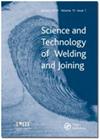用Ti/Cu和Ti/Cu/Nb/Ti/Cu箔连接石墨与Mo
IF 3.7
3区 材料科学
Q2 MATERIALS SCIENCE, MULTIDISCIPLINARY
Science and Technology of Welding and Joining
Pub Date : 2023-09-06
DOI:10.1080/13621718.2023.2255767
引用次数: 0
摘要
本文章由计算机程序翻译,如有差异,请以英文原文为准。
Joining of graphite to Mo using Ti/Cu and Ti/Cu/Nb/Ti/Cu foils
Graphite/Mo joining has been carried out using Ti/Cu or Ti/Cu/Nb/Ti/Cu foils. The joining region in the joint using Ti/Cu foils is mainly composed of Ti3Cu4 and TiCu. The joining region using Ti/Cu/Nb/Ti/Cu foils contains a joining zone I, an Nb interlayer and a joining zone II. Both the joining zones I and II are made up of Ti3Cu4 and TiCu. The Nb foil diffuses and dissolves into the liquid fillers during the bonding. The joint using Ti/Cu/Nb/Ti/Cu foils shows higher shear strength than that using Ti/Cu foils, implying the contribution of Nb foil to the joint stress relief and to the joint strength promotion.
求助全文
通过发布文献求助,成功后即可免费获取论文全文。
去求助
来源期刊

Science and Technology of Welding and Joining
工程技术-材料科学:综合
CiteScore
6.10
自引率
12.10%
发文量
79
审稿时长
1.7 months
期刊介绍:
Science and Technology of Welding and Joining is an international peer-reviewed journal covering both the basic science and applied technology of welding and joining.
Its comprehensive scope encompasses all welding and joining techniques (brazing, soldering, mechanical joining, etc.) and aspects such as characterisation of heat sources, mathematical modelling of transport phenomena, weld pool solidification, phase transformations in weldments, microstructure-property relationships, welding processes, weld sensing, control and automation, neural network applications, and joining of advanced materials, including plastics and composites.
 求助内容:
求助内容: 应助结果提醒方式:
应助结果提醒方式:


